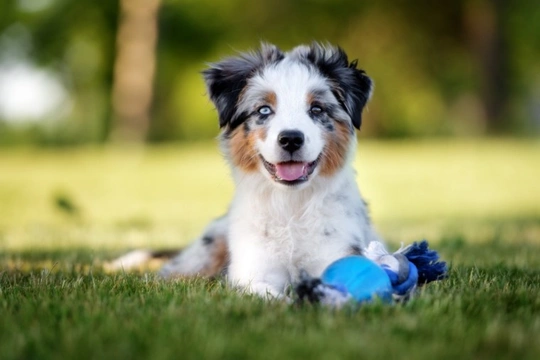
Why shouldn’t you breed two merle-coloured dogs together?
The word “merle” refers to an interesting coat colour and pattern combination that dogs of certain breeds can display, and which can be very variable in how it presents and which often, is very beautiful and distinctive to look at.
Merle is an accepted and in some cases, highly desirable colour within the breed standard of a great number of different dog breeds, whilst within some breeds, the colour is considered to be a fault or disadvantage.
However, one thing that cannot be denied is that the merle colour and pattern combination can be very appealing on individual dogs, and a great many puppy buyers every year choose a merle in preference to a different colour.
This means that many dog breeders are keen to produce merle dogs to meet the waiting demand of puppy buyers – but producing healthy merle dogs needs to be undertaken with care, because there are some risks involved in this too.
Whilst merle dogs of breeds from which the colour is accepted are usually as healthy and robust as any other dog and don’t suffer from health issues as a result of their merle colouration, breeding two merle dogs together can be a recipe for disaster, and is generally best avoided.
In this article we will explain why you shouldn’t breed two merle dogs with each other to produce double-merle puppies, and outline the potential problems and complications that can arise from merle-to-merle dog matings. Read on to learn more.
What is merle?
The word “merle” is used to refer to a distinctive coat colour and pattern combination, which can be very variable in appearance, but which results in mottled or flecked patches of colour across an otherwise solid or piebald coloured coat.
Merle colouration is often, but not always, accompanied by blue eyes or odd-coloured eyes of which one is blue, and the merle pattern is commonly replicated on the dog’s skin as well as in their coat.
Merle colouration in dogs occurs because of the presence of a specific gene, commonly known simply as the merle gene, which is a heterozygote of an incomplete dominant gene. This means that mating a merle dog with a non-merle dog will result in a one in two chance of each resultant pup themselves being merles.
Whilst this means that mating one merle parent produces a good chance of resulting in a number of merle pups, it is not a guarantee, and if merles are particularly desirable within the breed or among puppy buyers, may of course also result in the birth of pups with less desirable colours too.
If two merle dogs are mated with each other, all of the resultant pups will also be merles – and so you might fairly assume that this is the best way to guarantee a full merle litter. However, each pup produced from such a mating will have a one in four chance of inheriting two copies of the merle gene, resulting in what is known as double-merle colouration – and this can be a real problem.
The problems with double merles
Mating two merle dogs with each other ensures merle pups, but each of those pups will have a one in four chance of inheriting double merle colouration.
A double merle dog has a greatly elevated chance of inheriting not only their distinctive coat colour, but also a range of health problems too – such as hearing and vision defects, which in some cases, results in full blindness and/or deafness in the dog in question.
Significant eyesight and vision defects affect a significant number of double-merle dogs, and have an often acute impact on their quality of life and ability to exhibit normal, natural canine behaviours.
Interestingly, recent research indicates that most double-merle dogs that also inherit health issues carry the piebald gene along with their merle genes, rather than the genes for a solid colouration with merle.
The pedigree status of double-merle dogs
As a result of the greatly elevated risk of health issues that accompanies double merle colouration, the Kennel Club in the UK stopped offering pedigree registration to double-merle dogs (those produced from two merle parents) in 2013.
This means that even within dog breeds for which merle is an accepted colour (like the Cardigan Welsh corgi, Border collie and Dachshund – the latter breed within which the merle colour is referred to as “dapple”) dogs that display the double merle colouration are not eligible to be registered as pedigrees.
Additionally, the actual mating of two merle dogs together (regardless of whether or not any of their resultant pups are double merle) is forbidden within some dog breeds too, which may result in the whole litter being denied pedigree registration, even the single merle pups within it.
If you produce a double-merle puppy, they will not be eligible for Kennel Club registration, and responsible breeders are strongly advised against producing double merles, due to the increased risk of health issues that go along with the colour.
If you are considering buying a merle puppy of any breed, talk to the breeder about their ancestry, ask to see both parents, and review their pedigree paperwork to ensure that the pup in question has not inherited double merle colouration and so, an increased risk of health issues too.



